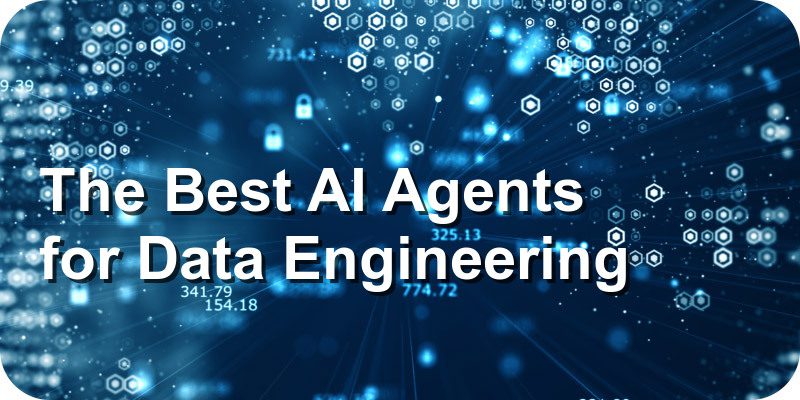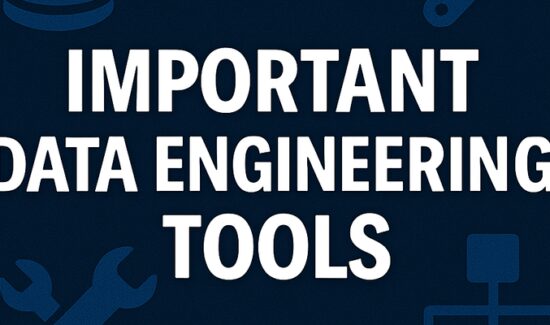The 27 Best AI Agents for Data Engineering to Consider in 2025


Solutions Review Executive Editor Tim King explores the emerging AI application layer with this authoritative list of the best AI agents for data engineering.
The proliferation of generative AI has ushered in a new era of intelligent automation — and AI agents are at the forefront of this transformation. From code-writing copilots and pipeline orchestration assistants to autonomous agents that validate data, monitor pipeline health, and streamline MLOps, AI agents are rapidly reshaping how modern data teams design, maintain, and scale their infrastructure.
In this up-to-date and authoritative guide, we break down the top AI agents and agent platforms available today for data engineering, grouped into clear categories to help you find the right tool for your specific needs — whether you’re building real-time ETL pipelines, managing complex data ecosystems, or embedding AI into your operational workflows.
This resource is designed to help you:
-
Understand what makes AI agents different from traditional data engineering and pipeline tools
-
Explore the capabilities and limitations of each available agent or agent-enabled platform
-
Choose the best solution for your team based on use case, architecture, and team size
Whether you’re automating data ingestion, monitoring pipeline health, orchestrating cross-cloud workflows, or embedding machine learning into infrastructure — there’s an AI agent for that.
Note: This list of the best AI agents for data engineering was compiled through web research using advanced scraping techniques and generative AI tools. Solutions Review editors use a unique multi-prompt approach to employ targeted prompts to extract critical knowledge to optimize the content for relevance and utility. Our editors also utilized Solutions Review’s weekly news distribution services to ensure that the information is as close to real-time as possible.
The Best AI Agents for Data Engineering
The Best AI Agents for Data Engineering: Data Pipeline Automation and Orchestration
Tools focused on automating data workflows, scheduling, and transformation.
Apache Airflow
Use For: Authoring and scheduling complex, dependency-aware data workflows
Apache Airflow is one of the most widely adopted open-source tools for workflow orchestration in modern data engineering. Originally developed at Airbnb and now part of the Apache Software Foundation, Airflow allows engineers to define workflows as Python-based DAGs (Directed Acyclic Graphs) — giving full control over task execution order, retries, failure alerts, and dependencies.
Airflow has become a cornerstone of production-grade data pipelines, powering everything from nightly ETL jobs to multi-step ML retraining pipelines. Its flexible, plugin-friendly architecture enables seamless integration with virtually any system or service in the modern data stack.
Key Features:
-
Define workflows in Python for full programmatic control
-
Built-in scheduler and executor for running tasks in order or parallel
-
Extensible with hundreds of community-contributed operators (e.g., BigQuery, Snowflake, Spark, Kubernetes)
-
Centralized UI for tracking DAG runs, task logs, and job status
Get Started: Use Apache Airflow when you need fine-grained control over complex pipelines, especially in batch processing, data warehouse jobs, or ML model orchestration — and when your workflows involve multiple interdependent systems or tools.
Prefect
Use For: Modern, Pythonic orchestration of data workflows with better observability and lower setup overhead than Airflow
Prefect is a next-generation workflow orchestration platform designed as a modern alternative to Apache Airflow. With a code-first, Python-native interface, Prefect lets developers define workflows using intuitive constructs called Flows and Tasks, rather than complex DAGs. It emphasizes observability, flexibility, and ease of use, making it especially appealing to agile data teams.
Prefect is built to support both local development and enterprise-scale production deployments, offering hybrid execution (run locally, monitor in the cloud) and automatic retries, caching, and parameterization out of the box.
Key Features:
-
Python-native workflow definitions — no custom DSL or configuration files
-
Cloud or on-prem monitoring of job runs, logs, failures, and retries
-
First-class integrations with tools like dbt, Snowflake, GCS, S3, and Kubernetes
-
Dynamic workflows, parameterization, and input/output passing
Get Started: Use Prefect when your data engineering team wants a modern, developer-friendly orchestration tool that offers both local flexibility and production-ready monitoring — perfect for fast-moving teams that value observability and clean code.
Luigi
Use For: Lightweight orchestration of batch data workflows and pipeline dependencies
Luigi is an open-source Python package developed by Spotify for building batch data pipelines with complex task dependencies. It allows users to create workflows by defining Python classes for each task, specifying input/output requirements, and linking them via dependency chains. Luigi is especially useful for internal automation, batch processing, and building one-off jobs that need to run in a specific order.
While not as feature-rich or scalable as Airflow or Prefect, Luigi remains a trusted option for simpler, dependency-aware workflows — especially when low infrastructure complexity and high customizability are priorities.
Key Features:
-
Define tasks as Python classes with dependency logic baked in
-
Automatically resolves task order and ensures upstream completion
-
Visualizes workflow execution and status in a simple web UI
-
Works well for file-based, database, or shell-script-based pipelines
Get Started: Use Luigi when you need a simple, Python-native orchestration framework for running ETL jobs or automation scripts with clear dependencies — ideal for smaller workflows or development environments.
Mage AI
Use For: Notebook-style pipeline building with AI-powered suggestions and smart debugging
Mage AI is a modern open-source data pipeline tool that blends the flexibility of notebooks with the robustness of a workflow orchestration engine. Built for the modern data stack, Mage lets users build, visualize, and debug data pipelines in a low-code interface using Python, SQL, and R — all while offering AI-driven insights to help optimize logic, catch errors, and accelerate development.
Mage is particularly appealing to smaller data teams or analytics engineers who want a smooth UX, fast iteration cycles, and helpful guidance without having to manage complex infrastructure.
Key Features:
-
Notebook-style UI for building batch and streaming pipelines
-
Support for Python, SQL, and R tasks
-
Real-time pipeline execution with step-by-step visual monitoring
-
AI-powered suggestions for error resolution and performance optimization
-
Native integration with Snowflake, BigQuery, Redshift, Databricks, and more
Get Started: Use Mage AI when your team wants an intuitive, visual environment to build and debug pipelines, especially in fast-moving analytics environments where speed, clarity, and low overhead matter more than raw orchestration power.
Dagster
Use For: Asset-centric orchestration with strong data lineage, testing, and governance support
Dagster is a modern workflow orchestration platform that reimagines pipelines as a system of data assets rather than just a chain of tasks. Instead of focusing solely on execution order, Dagster emphasizes data lineage, types, documentation, and validation, giving engineers greater control over the lifecycle and quality of the data being processed.
Built with software engineering principles and data quality in mind, Dagster helps teams structure ELT pipelines, ML workflows, and analytics systems in a way that is testable, debuggable, and transparent.
Key Features:
-
Declarative, asset-driven pipeline definitions in Python
-
Automatic lineage tracking and metadata for every pipeline run
-
First-class support for testing, logging, and monitoring
-
Integrations with dbt, Spark, Snowflake, Redshift, S3, and more
-
Rich UI with visual DAGs, asset graphs, and event logs
Get Started: Use Dagster when you want to treat data pipelines as a well-governed system of reproducible assets, particularly in environments where lineage, quality, and modularity are core concerns.
CrewAI
Use For: Coordinating multiple specialized AI agents to work collaboratively on complex data workflows
CrewAI is an emerging open-source framework that allows developers to create and orchestrate teams of AI agents — each with a defined role, objective, and responsibility. Built to simulate real-world collaboration, CrewAI enables agents to communicate, plan, delegate, and execute tasks in sequence or parallel, making it a unique tool for advanced data engineering automation.
For data engineers, CrewAI is a powerful experimental playground for automating data validation, transformation, documentation, and monitoring, assigning agents to handle distinct pipeline components (e.g., one for QA, one for ingestion), simulating how human teams coordinate on engineering workflows, and prototyping intelligent systems that plan, execute, and self-improve.
Key Features:
-
Multi-agent collaboration with memory, role assignment, and task delegation
-
Integration with LLMs like GPT-4, Claude, or custom APIs
-
Command-line or Python-based configuration with modular architecture
-
Ability to define reusable roles (e.g., Data Cleaner, SQL Generator, Pipeline Auditor)
Get Started: Use CrewAI when you’re exploring next-gen AI automation by assigning multiple agents to collaborate on distinct stages of a data pipeline — a great fit for innovation labs, internal R&D, or agent-based system exploration.



















